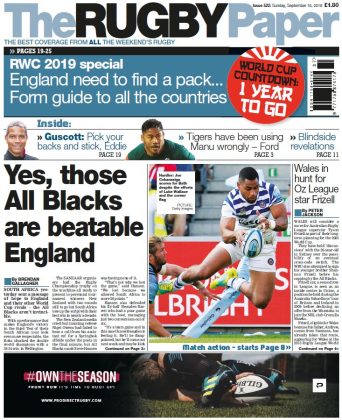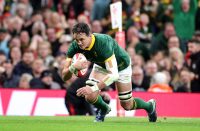By Jeremy Guscott
Eddie Jones has a massive challenge a year out from RWC 2019 – he hasn’t got a settled back line which is far from ideal. In contrast the best two teams in the world have number one picks in all positions and, most importantly, a half back pairing that picks itself, Aaron Smith/Beauden Barrett and Conor Murray/Johnny Sexton.
Familiarity between players helps with understanding of moves and reading of each other, and while the overall theme is one of continuity, the surprising thing since Jones came in is that there has not been a run of games where all seven players in the backline are constantly in favour.
For instance, we’ve had two years on and off of Ben Youngs at scrum-half, and then a year of Danny Care. The best fly-half in England is Owen Farrell, but he has barely played in the 10 shirt under Jones even though on big occasions George Ford has sometimes been found wanting.
Jonathan Joseph has also been dropped occasionally at outside-centre, and he’s currently not being considered because of injury. This gave England the opportunity to experiment with Henry Slade at 13 in South Africa.
There has also been a bit of a merry-go-round on the wings, with Anthony Watson the number one choice despite a spell on the sidelines injured. Seeing that Elliot Daly has also become a regular choice on the wing – and in South Africa recently at full-back – it means that Jack Nowell and Jonny May have been in and out of the side. The same applies to Mike Brown, who was swapped from full-back to wing for the summer series against the Springboks.
It should be no surprise, therefore, that if you asked four different people for their England backline you would almost certainly get four different line-ups. A recurring theme under Jones has been positional interchange, and almost all of them are utility backs at the moment. However, by the end of the Autumn series you would hope that the coach has his World Cup backline mapped out.
That is especially true of the big decision-makers at scrum-half and fly-half. What happens at 10 will be crucial, and Jones has some big calls to make about whether to go with Danny Cipriani or Ford – or finally to move Farrell, who is the alpha male in the England backline, to his Saracens club position of fly-half rather than playing him at inside-centre.
Assuming everyone is fit my first-choice England backline is Youngs at 9 (if he is at his very best), Farrell at 10, Ben Te’o at 12, Daly at 13, with newcomer Joe Cokanasiga and Nowell on the wings, and Watson at full-back.

I am not too worried about workload because of all the players on the pitch the backs are the guys who should be able to go for 80 minutes. It might be a little different with some of the big guys in the centre, like Te’o, who so far has been at his most effective when he’s come off the bench as a 30 minute impact player.
I’ve moved Daly to outside-centre because he is very dangerous – as his try against Exeter playing 13 for Wasps last weekend emphasised – and I want the ball in his hands as often as possible, which doesn’t happen enough on the wing.
I’ve picked Nowell at wing because he is good under the high ball and also always appears to make ground – he has the ability and footwork to beat defenders for fun. I’ve gone for Cokanasiga on the other wing because having a big, fast, aggressive runner who is hard to defend against provides England with another variation, and it gives the added bonus of being able to play Watson at full-back. With Watson sidelined for the Autumn with an Achilles problem, I would put Daly at full-back and call up Alex Lozowski to No.13 with Slade on the bench.
I would like to see more of Lozowski in an England shirt and he would be my utility back moving forward, just ahead of Slade. Assuming there are three backs on the bench, I would have Cipriani as fly-half cover, and whoever was in sharpest form out of Care and Dan Robson as replacement scrum-half.
It is not easy to leave out May after his great form in the series against South Africa, but you have to look at the backline as a whole and make hard choices – and at the moment he is not one of my first picks. The same applies to Joseph, who scores tries and is difficult to ignore – but game-breakers have to get their hands on the ball, and he doesn’t do it enough.
It really is crunch time for Jones, and by the same token it is about time that England’s backs started to put their hands up by performing to such a high standard consistently that they make it impossible for him to leave them out. It’s been a long time coming, but that’s where the England backline has to be this season.
Youngs is difficult to displace, and he gets in because his box-kicking is better than the others. I like the gain-line power offered by Te’o at 12 and Cokanasiga coming off his wing because it gives you an abrasive element where the other options are more subtle second play-makers.
England have obviously employed the 10-12 system of two distributors, with Ford and Farrell continuing their midfield partnership under Jones. However, I have believed for a long time that England are at their best when, like Saracens do with Brad Barritt, you have your inside-centre coming onto the short ball hard and fast. That’s the English way.

If Te’o takes on the Barritt role, having a big hard running 12 has the dual benefit of getting you over the gain-line and recycling quick ball, while at the same time giving you a decoy option to work the ball wide and keep the defence in two minds.
A fit Manu Tuilagi gives you that same power and impact in midfield, but he is not match fit yet. Although he scored a nice try last weekend for Leicester against Newcastle he is still a bit slow getting back in position and needs to get more game time.
England’s back play is a level below the Lions, but Saracens and Exeter epitomise what works best in our attacking game – and this side has to play the England way rather than trying to be New Zealand, Australia or South Africa.
England are at their most successful when they play with brutal hard-running centres who get them over the advantage line, and from there it is about executing accurately. It’s basic rugby, played with intensity and accuracy.
It’s hard to play effectively without one or two big straight runners in the backline, because you cannot rely on your forwards to generate all the momentum. Te’o and Cokanasiga can provide that because they are capable of running through people rather than round them.
It’s difficult to rate how good England could be by the World Cup because they are so inconsistent at the moment, and also because any team struggles without a dominant pack of forwards.
Even so, England do have X-factor backs. Daly is the most dangerous back in Europe, Nowell is as elusive as any back three runner in Test rugby, and Farrell has been one of the best midfield backs in the international game for the past four seasons. What is required now is for the rest of the England backs to match Farrell’s consistency.
The Rugby Paper is on sale all year round! It’s time to get ready for the autumn internationals. Subscribe: http://bit.ly/TRP-Sub
























